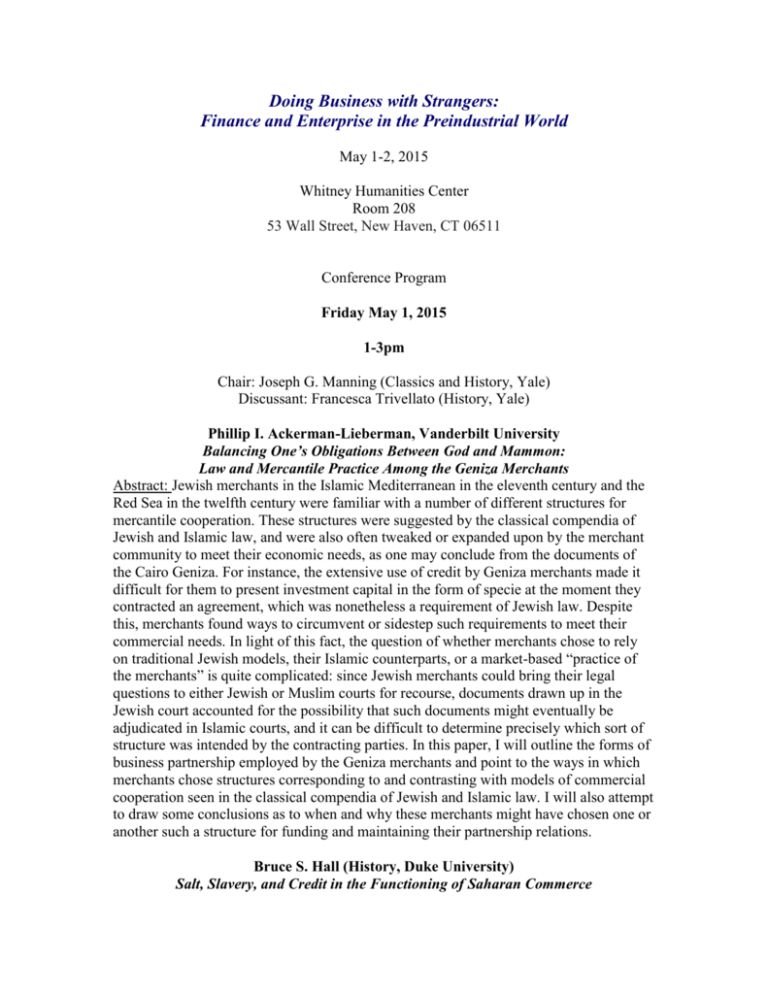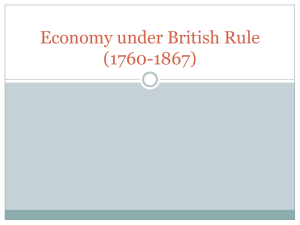Finance and Enterprise in the Preindustrial World
advertisement

Doing Business with Strangers: Finance and Enterprise in the Preindustrial World May 1-2, 2015 Whitney Humanities Center Room 208 53 Wall Street, New Haven, CT 06511 Conference Program Friday May 1, 2015 1-3pm Chair: Joseph G. Manning (Classics and History, Yale) Discussant: Francesca Trivellato (History, Yale) Phillip I. Ackerman-Lieberman, Vanderbilt University Balancing One’s Obligations Between God and Mammon: Law and Mercantile Practice Among the Geniza Merchants Abstract: Jewish merchants in the Islamic Mediterranean in the eleventh century and the Red Sea in the twelfth century were familiar with a number of different structures for mercantile cooperation. These structures were suggested by the classical compendia of Jewish and Islamic law, and were also often tweaked or expanded upon by the merchant community to meet their economic needs, as one may conclude from the documents of the Cairo Geniza. For instance, the extensive use of credit by Geniza merchants made it difficult for them to present investment capital in the form of specie at the moment they contracted an agreement, which was nonetheless a requirement of Jewish law. Despite this, merchants found ways to circumvent or sidestep such requirements to meet their commercial needs. In light of this fact, the question of whether merchants chose to rely on traditional Jewish models, their Islamic counterparts, or a market-based “practice of the merchants” is quite complicated: since Jewish merchants could bring their legal questions to either Jewish or Muslim courts for recourse, documents drawn up in the Jewish court accounted for the possibility that such documents might eventually be adjudicated in Islamic courts, and it can be difficult to determine precisely which sort of structure was intended by the contracting parties. In this paper, I will outline the forms of business partnership employed by the Geniza merchants and point to the ways in which merchants chose structures corresponding to and contrasting with models of commercial cooperation seen in the classical compendia of Jewish and Islamic law. I will also attempt to draw some conclusions as to when and why these merchants might have chosen one or another such a structure for funding and maintaining their partnership relations. Bruce S. Hall (History, Duke University) Salt, Slavery, and Credit in the Functioning of Saharan Commerce Abstract: Islamic jurisprudence establishes a set of licit frameworks by which merchants can raise capital in order to engage in long-distance trade. Yet in practice, these formal mechanisms for raising commercial capital were often legal fictions meant to get around troublesome restrictions on customary trading practices. In this paper, I explore some of the issues that arose around problems of credit and partnership using both commercial correspondence from a nineteenth-century trade network based in Timbuktu and legal opinions drawn from some of the most important fatwa collections produced in Muslim Western Africa between the 17th and early 20th centuries. These sources reveal some of the particularity of the functioning of commerce in the interior of pre-colonial Western Africa which did not meet the stipulations of Islamic law, but which was justified in terms of high levels of commercial (and ethical) risk. By putting sources which reveal details of the commercial practice of a single network into dialogue with a more abstract regional discourse about the legality (and morality) of particular arrangements that supported trade, the paper reveals some of the historical mechanisms of credit and the anxieties that accompanied them in this part of Africa. Coffee Break 3:30-5:30pm Chair: Eric Hilt (Economics, Wellesley and Yale) Discussant: Christopher Udry (Economics, Yale) Cihan Artunç (Economics, University of Arizona) Firm Organization in Egypt between 1910 and 1949: Evidence from the Mixed Courts Abstract: What is the link between legal forms of firm organization and business expansion? As a first attempt in a broader project that examines the implications of legal rules in the Middle East’s economic outcomes, this paper uses novel data from the Mixed Court registers between 1910 and 1949. In 1876, Egypt established a judicial system called the Mixed Courts to solve the problems legal pluralism created. These courts largely applied the French commercial code and introduced European enterprise forms. I construct a cohort of firms between 1910 and 1949 using extracts of partnership agreements and dissolutions, which the Mixed Courts published. The data show that ordinary and limited partnerships dominated Egypt’s commercial life. Limited partnerships, in many ways, were organized similar to ordinary partnerships to place firms under the jurisdiction of Mixed Courts. Most partnerships had short duration, dissolving within two years after their establishment. The data support that business patterns did not deviate much from European or pre-reform Middle Eastern partnerships. Finally, the data show that there was greater business expansion and churning during periods of higher economic growth. Madeleine Zelin (History, Columbia University) Local Knowledge: Explorations in China's Encounter with the Modern Company Abstract: This paper is part of a larger study that examines cultural contact in a global setting through the lens of the contest between Western-style corporate law and Chinese local investment practice in the semi-colonial world of early twentieth century China. It revisits one-way theories of legal transfer by focusing instead on the processes by which 2 legal concepts are introduced, the non-legal meanings they acquire, the new kinds of documents they produce, the special place they occupy in debates over national identity. Focusing in particular on Chinese partnership practices in the shadow of efforts to introduce a new company law in the early twentieth century, I hope to shed new light on both Chinese traditions of shareholding and business organization and reopen debates over China’s failure to develop the “modern corporation.” Saturday May 2, 2015 9:30-12 Chair: José-Antonio Espin-Sanchez (Economics, Yale) Discussant: Naomi Lamoreaux (Economics and History, Yale) Lutz Kaelber (Sociology, University of Vermont) Financing Business: Max Weber on Equity and Debt in Medieval Partnerships Abstract: To finance its operation, a business can rely on equity or debt, or both. How did this take place in the Middle Ages? Max Weber explored this question in his dissertation and first book, The History of Commercial Partnerships in the Middle Ages (1889/2003). Based on an analysis of a variety of primary records, Weber wrote about equity financing in various forms of commercial partnerships, predominantly in late medieval Italy, and debt financing, which involved the taking of interest and touched on usury laws. This paper outlines Weber’s major findings and arguments, and addresses some of the recent scholarship on these matters as it relates to Weber’s studies. Yadira González de Lara (Economics, University of Valencia) The Impact of Formal Monitoring on Financial Development: From Debt to Equity in Late Medieval Venice Abstract: In late-medieval Venice the state regulated the ex-ante operation of trading voyages in a manner that facilitated the ex-post verification of merchants' accounts. Specifically, colonial governors, convoy admirals, ship scribes, tax collectors and various other officials monitored merchants at all times, thereby generating and transmitting (verifiable) information which investors could present as evidence in support of their claims to the court. Formal monitoring thus enhanced the legal protection of investors from expropriation by controlling merchants and fostered the development of equity markets. The Venetian institutional system thus went far beyond the informal relations of trust that facilitated the transition from the debt-like sea-loan to the equity-like commenda contract in other Mediterranean localities at basically the same time. This paper investigates the distinctive nature of the Venetian institutions, their different efficiency and distribution implications and their evolution over time. Nadia Matringe (History, CNRS-Paris) Credit Reallocation & the Financing of International Trade: Deposit Banking in Sixteenth-Century Lyons 3 Abstract: This paper presents the perspective of economic operators to help understanding the functioning of the credit market --on the assumption that the study of economic development cannot dispense with the analysis of the stakeholders who run the market. Based on the archives of one of Lyon’s most prominent firms, the Salviati, it analyses a credit instrument that has raised little interest among historians of the early modern period: the fair deposit. Even though deposit banking is frequently evoked to explain the reserves of great Italian and German banks active on the international fair locations of the 16th century, and probably because it appears to be a an obvious and well known procedure, the fair deposit has never been the object of any advanced study. This lack of interest appears to be related to the distinction established by the historiography between local banking and international trade. Many scholars have indeed emphasized that the origins of deposit banking lie in manual exchange, i.e., the conversion of species materially present at a single location. In medieval Italian and Flemish cities, this operation was the specialty of local banks, which were not, at least never directly, involved in international trade. The historiography of deposit banks thus tends to merge with that of public credit institutions and local private banks, while the studies devoted to international firms almost never dwell on deposit banking, which is considered to be of secondary importance at the great marketplaces and among international trading networks. Recourse to the Salviati archives renders it possible to go beyond the traditional approach of deposit banking, and to show its evolution during the course of the 16 th century, in the context of the development of important exchange fairs. It shows, first of all, that the Salviati and their homologues on the Lyons marketplace do not use deposit banking to increase their own liquidity reserves but to lend and borrow money for others, playing the role of credit intermediaries. In their account books, deposits appear to be mostly bank money used to transfer credit and grant charged overdrafts. The plasticity of this credit instrument is manifest by the variations of the term and the interest rate of each operation according to the economic context and the decisions and capacities of the bankers. From the perspective of the banks that practice it, deposit banking assumes a double function: the creation of wealth, but also the maintaining and development of social capital. Far from being restricted to the local or regional space, the credit mobilized through deposit comes mostly from international trade and finance, where it is also reinjected. The main creditors of the Salviati bank are important bankers and financiers of Jewish origin (especially the Mendes), who seek to shield their capital from the avarice of the authorities. The majority of deposits are lent to Lyons banks, which use them to buy credit on foreign marketplaces through the bill of exchange. Overdrafts granted to the Lyons banks is a primary element in the streamlined functioning of international clearance, since it ensures the final balancing of all debts among the fair banks. The second most important group of borrowers is composed of merchandise exporters located abroad. Monies advanced to them allow them to purchase new products before encashment of revenues from sales made for them in Lyons. The fair deposit thus appears to be a credit instrument at the service of international trade and banking. The advantageous position of Lyons in international trade and the secrecy of Italian firms, illustrated by the use of cover-names, encourage investments — 16th century Lyons thus being the equivalent of our modern financial havens. 4 An analysis of the fair deposit in Lyons through the Salviati archives thus exhibits the primary importance of this banking practice in the financing of international trade in the 16th century. Far from evidencing a preliminary stage of banking organization, study of the fair deposit documents a crucial moment in the financial history of Europe, showing the emergence of specialized bodies for rendering financial services. This evolution is the consequence of as well as the response to the growth of international trade and the stock price in the early modern age. Lunch 1-3:30pm Chair: Timothy Guinanne (Economics, Yale) Discussant: Philip Hoffman (Economics, Caltech) Bram Van Hofstraeten (History, Maastricht University) Opting for Private Partnerships in Early Modern Antwerp (1480-1620) Abstract: As soon as the traveling merchant started to make way for his sedentary counterpart, capital or goods no longer constituted the sole requirement for trading activities. In addition, representation in multiple markets became an indispensable condition for the execution of commercial transactions. Whereas the requirement of finance had already led to the development of various credit instruments like bills obligatory, interest-bearing deposits and bills of exchange, the prerequisite of (multiple) representation produced the conception of agency, more specifically salaried agents (factors) and commission agents. Private partnerships, in their turn, comprised a response to both necessities. Through the idea of the joint and several liability of all constituting partners, it increased trust between the latter and, thus, it improved its use as a reliable means of representation. On the other hand, as an equity contract, it contributed to the funding of trade whereby the investment of others was rewarded by sharing in the profits of the company. This paper scrutinizes the determinants that incited early modern merchants in Antwerp to opt for the establishment of private partnerships, both as a means of funding as well as a means of agency. In order to do so, it makes use of a collection of 144 partnership agreements that had been registered by Antwerp notaries in the course of the long sixteenth century (1480-1620). An in-depth analysis of the contracting parties as well as the objectives of the respective commercial companies, will clarify the circumstances and reasons that incited early modern merchants in Antwerp to take recourse to an equity contract. In so doing, the paper will distinguish between various types of private partnerships that could be identified on the sixteenth-century Antwerp market, more specifically the general partnership and the limited partnership. Joost Jonker (History, Utrecht University) and Oscar Gelderblom (History, Utrecht University) Direct Finance in the Dutch Golden Age Abstract: he funding of modern business relies heavily on banks, securities markets, and other financial intermediaries. These forms of indirect finance became dominant from the 5 late nineteenth century, as the rise of big business boosted demand for external funding. They supposedly rooted in earlier instances of deposit banking and securities trading, as practiced notably in Italy, Flanders, Holland, and Britain from the Middle Ages onwards. But pedigrees like this are as appealing as they are suggestive, not to say misleading. They rely on a continuity that is implied rather than proven, and they disregard institutional arrangements that do not fit the evolutionary model culminating in today’s hallmark institutions. In this paper we investigate one such alternative arrangement: the direct financing of business in the Dutch Golden Age in the form of trade credit or loans contracted on the money market. We do this in order to understand why Amsterdam, for all its early financial sophistication, did not develop deposit banking during its heyday. We analyze both the institutional set-up of Amsterdam's financial market in the seventeenth century and the loan portfolios of two leading businessmen and investors, Louis Trip (1605-1684) and Joseph Deutz (1624-1684). Comparing the return these lenders made on money market loans with the yield on safe assets, we find that the narrow spread between borrowing and lending prevented financiers like Trip and Deutz from scaling up their operations into banking proper. Jessica Hanser (History, Yale-NUS) The Canton Debts Crisis, 1779-81 Abstract: Between 1760 and 1770, Chinese tea imported by the British East India Company into Britain nearly tripled from three to nine million pounds per year. Business was booming for both the British and Chinese. Yet by 1779, half of the Chinese Hong merchants licensed to trade with the British went bankrupt; they defaulted on approximately £1,000,000 in British loans. In fact, the year 1779 saw a major collapse of trust between British and Chinese merchants, resulting in a British Navy gunboat being dispatched to Canton. What does the Debts Crisis tell us about cross-cultural credit and finance in eighteenth-century Canton? High volume commerce between the British East India Company and Chinese Hong merchants in Canton during the 1760s and 70s led both sides scrambling to finance their ends of the trade. In the end, both the British and Chinese came to rely increasingly on the financial services of British private traders. These private traders established themselves as commission merchants in Canton, and acted as agents of Company servants mainly based in India on whose behalf they lent significant sums to the East India Company and to the Hong merchants. They greased the wheels of global commerce between Britain and China. The Debts Crisis of 1779 reveals several significant aspects of cross-cultural trade and finance in Canton. A shortage of money in China, a surplus of private British wealth (particularly in India), and a difference in interest rates in the two places, helped to draw capital from India to China. Even though it was illegal for foreigners to lend money to Chinese subject, practice was quite different; British lenders had come to expect Chinese officials and East India Company servants to help arbitrate disputes. As a result, a lagre bond market for Chinese debt had developed and was functioning in Canton for several decades. When both the Chinese officials and EIC servants uncharacteristically hesitated to intervene, the lenders panicked, the bond market collapsed, and trade came to a halt. 6









